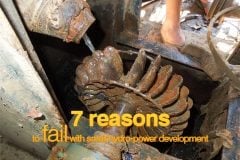Future power
As the world discovers new ways to meet its growing energy needs, energy generated from Sun, which is better known as solar power and energy generated from wind called the wind power are being considered as a means of generating power.
Though these two sources of energy have attracted the scientists for a very long time, they are not able to decide, which of the two is a better source to generate power. Now scientists are looking at a third option as well.
Scientists at Washington State University have now combined solar power and wind power to produce enormous energy called the solar wind power, which will satisfy all energy requirements of human kind.
Advantages of Solar wind power.
- The scientists say that whereas the entire energy generated from solar wind will not be able to reach the planet for consumption as a lot of energy generated by the satellite has to be pumped back to copper wire to create the electron-harvesting magnetic field, yet the amount that reaches earth is more than sufficient to fulfill the needs of entire human, irrespective of the environment condition.
- Moreover, the team of scientists at Washington State University hopes that it can generate 1 billion billion gigawatts of power by using a massive 8,400-kilometer-wide solar sail to harvest the power in solar wind.
- According to the team at Washington State University, 1000 homes can be lit by generating enough power for them with the help of 300 meters (984 feet) of copper wire, which is attached to a two-meter-wide (6.6-foot-wide) receiver and a 10-meter (32.8-foot) sail.
- One billion gigawatts of power could also be generated by a satellite having 1,000-meter (3,280-foot) cable with a sail 8,400 kilometers (5,220 miles) across, which are placed at roughly the same orbit.
- The scientists feel that if some of the practical issued are solved, Solar wind power will generate the amount of power that no one including the scientists working to find new means of generating power ever expected.
How does the Solar wind power technology work?
The satellite launched to tap solar wind power, instead of working like a wind mill, where a blade attached to the turbine is physically rotated to generate electricity, would use charged copper wire for capturing electrons zooming away from the sun at several hundred kilometers per second.
Disadvantages of Solar wind power
But despite the fact that Solar wind power will solve almost all the problems that we were to face in future due to power generating resources getting exhausted, it has some disadvantages as well. These may include:
- Brooks Harrop, the co-author of the journal paper says that while scientists are keen to tap solar wind to generate power, they also need to keep provisions for engineering difficulties and these engineering difficulties will have to be solved before satellites to tap solar wind power are deployed.
- The distance between the satellite and earth will be so huge that as the laser beam travels millions of miles, it makes even the tightest laser beam spread out and lose most of the energy. To solve this problem, a more focused laser is needed.
- But even if these laser beams reach our satellites, it is very doubtful that our satellites in their present form will be able to tap them. As Greg Howes, a scientist at the University of Iowa puts it, “The energy is there but to tap that energy from solar wind, we require big satellites. There may be practical constraints in this.”











Great idea! Hope it will give results they expect.